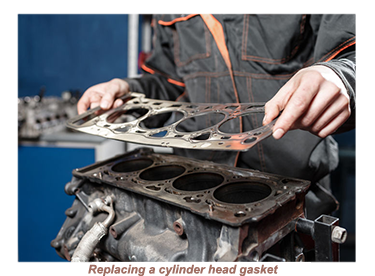
 The cylinder head's primary function is to top-close the engine's combustion chamber. The cylinder head is the top portion of the engine, and the engine block is the bottom portion. The combustion chamber is sealed off by the cylinder head, which is mounted on the engine. The head gasket fills in the remaining space between the cylinder head and the engine, meaning that e continuous lubrication of the cylinder is another crucial component of how the engine works
The cylinder head's primary function is to top-close the engine's combustion chamber. The cylinder head is the top portion of the engine, and the engine block is the bottom portion. The combustion chamber is sealed off by the cylinder head, which is mounted on the engine. The head gasket fills in the remaining space between the cylinder head and the engine, meaning that e continuous lubrication of the cylinder is another crucial component of how the engine works
Without properly lubricated cylinders, the engine will fail to operate smoothly.
Due to its intricate structure, the cylinder head is not only one of the most crucial components in a classic car engine but also one of the most expensive. The cylinder head is made of durable aluminium alloys and light metals since it is subjected to extremely high temperatures during the combustion process.
A cylinder head is normally closed at the top with a valve cover and fastened directly to the crankshaft housing at the bottom.
![]()
![]() Look for any signs of coolant or oil leaks around the cylinder head. Leaks could indicate a problem with the head gasket, cylinder head bolts, or other components.
Look for any signs of coolant or oil leaks around the cylinder head. Leaks could indicate a problem with the head gasket, cylinder head bolts, or other components.
![]() Perform a compression test on each cylinder to ensure that the engine is producing the proper amount of compression. Low compression can indicate a problem with the cylinder head, valves, or piston rings.
Perform a compression test on each cylinder to ensure that the engine is producing the proper amount of compression. Low compression can indicate a problem with the cylinder head, valves, or piston rings.
![]() Check the operation of the valves to ensure that they are opening and closing properly. If the valves are not functioning correctly, it could indicate a problem with the valve seats, valve guides, or valve springs.
Check the operation of the valves to ensure that they are opening and closing properly. If the valves are not functioning correctly, it could indicate a problem with the valve seats, valve guides, or valve springs.
![]() Inspect the cylinder head for any signs of damage, such as cracks or warping. Damage to the cylinder head could indicate a problem with overheating or improper installation.
Inspect the cylinder head for any signs of damage, such as cracks or warping. Damage to the cylinder head could indicate a problem with overheating or improper installation.
![]() Look for any signs of deposits or build up on the cylinder head, valves, or combustion chamber. Deposits can indicate a problem with the fuel or oil system or a lack of maintenance.
Look for any signs of deposits or build up on the cylinder head, valves, or combustion chamber. Deposits can indicate a problem with the fuel or oil system or a lack of maintenance.

![]() Test the coolant for signs of contamination or exhaust gases. Contaminated coolant or exhaust gases in the coolant can indicate a problem with the cylinder head gasket or cylinder head.
Test the coolant for signs of contamination or exhaust gases. Contaminated coolant or exhaust gases in the coolant can indicate a problem with the cylinder head gasket or cylinder head.
![]() The cylinder head relies on a steady supply of clean oil to function properly. Use the correct type of oil for classic car classic car and change it according to the manufacturer's recommended schedule.
The cylinder head relies on a steady supply of clean oil to function properly. Use the correct type of oil for classic car classic car and change it according to the manufacturer's recommended schedule.
![]() The oil level should be checked regularly to ensure that it is at the proper level. Low oil levels can cause the cylinder head to run dry and become damaged.
The oil level should be checked regularly to ensure that it is at the proper level. Low oil levels can cause the cylinder head to run dry and become damaged.
![]() Oil pressure should be checked regularly to ensure that it is at the proper level. Low oil pressure can cause the cylinder head to run dry and become damaged.
Oil pressure should be checked regularly to ensure that it is at the proper level. Low oil pressure can cause the cylinder head to run dry and become damaged.

![]() Look for any oil leaks that may be coming from the cylinder head or the surrounding area. Leaks should be repaired promptly to prevent the cylinder head from running dry.
Look for any oil leaks that may be coming from the cylinder head or the surrounding area. Leaks should be repaired promptly to prevent the cylinder head from running dry.
 It's a good idea to have the cylinder head serviced by a mechanic on a regular basis to ensure that it is in good condition. This can include cleaning, inspecting, andreplacing any worn parts.
It's a good idea to have the cylinder head serviced by a mechanic on a regular basis to ensure that it is in good condition. This can include cleaning, inspecting, andreplacing any worn parts.
By following these tips and regularly maintaining a classic car's cylinder head, you can help ensure that it stays in good working condition for many years to come.
Back to the homepage- and don't spare the horsepower.
me4



